So, your Android app is built, polished, and ready to hit the market. Next up is publishing it on the Google Play Store — a task that may seem daunting at first. We get it: if you do it wrong, your app may never see the light of day.
Don’t worry — we’ve got you covered. Today, we will guide you through a smooth launch on the Google Play Store, which is undoubtedly the leader in the number of published apps and users, with over 2 million apps.
Step 1: Create a Play Console developer account
Before diving into the specifics of publishing your app, let's make sure you have all the essentials in place. Creating a Google Play Console developer account is something you can (and should) do at the beginning of the app development process. Without it, you can't publish your app on the Play Store.
You can use any of your current Google accounts or create a dedicated one to sign up for a Google Play Console developer account. While both personal and corporate accounts can publish apps, you need to submit a formal transfer request to Google. To avoid this, choose the correct account type from the start.
Signing up for a Google developer account involves the following steps:
- Agree to the Google Play Developer Distribution Agreement.
- Pay a one-time registration fee of $25.
- Provide required information (developer name, legal name and address, contact email, and phone number).
- Choose between a personal or corporate account. Keep in mind that developers with personal developer accounts must meet certain app testing requirements before they can distribute their app on Google Play. Also, since 2024, developers with new personal accounts need to verify access to a real Android device using the Play Console mobile app.

Keep in mind that developers with personal developer accounts must meet certain app testing requirements before they can distribute their app on Google Play. Also, since 2024, developers with new personal accounts need to verify access to a real Android device using the Play Console mobile app.
Typically, it takes from a few hours to a few days to get your account approved by Google. If there are any issues with identity verification or payment processing, expect the approval process to take longer.
Step 2: Add a Merchant account
If you plan to sell paid apps or in-app purchases, you have to create a Google Merchant Account. A Google Merchant Account will help you manage app sales and your monthly payouts, as well as analyze sales reports.
Once you finish creating the Merchant profile, the developer account gets automatically linked to it.
Step 3: Prepare the documents
Before publishing, you need to prepare legal documents, such as an End User License Agreement (EULA) and Privacy Policy. Based on our experience, we highly recommend starting to prepare these documents in advance. If these documents aren’t ready upfront, you may have to pause submission or make last-minute edits.
You can use documents from similar apps as references and create your own based on them, or ask a lawyer to make everything from scratch.
End User License Agreement (EULA)
EULA is an agreement between a product owner and a user of the product. In brief, it contains:
- What the users can do with the app and what they aren't allowed to do
- Licensing fees
- Third-party services your app relies on, etc.
Privacy Policy
A Privacy Policy is a legal document that outlines how your app collects, uses, stores, and shares personal information from its users.
Make sure to include the following information in the Privacy Policy:
- A complete list of personal data that is collected, processed, and used through the app
- Technical information that is collected about the device and the installed OS
- Functional features of the app, its paid and free functionality
- Place of registration of the company and/or location of the copyright holder of the application
- The chosen legal system and legislation that will be applied in resolving disputes and regulating legal relations
- The terms of the subscription
- Citizenship (residence) of the overwhelming majority of application users
- Age criteria, the presence of specific content
While Google Play doesn't require you to have a Terms of Use document for your app, it's a highly recommended practice. Terms of Use or Terms and Conditions explain how users can interact with your app and what to expect. You can combine Privacy Policy and Terms of Use into a single document, with separate chapters for each.
Step 4: Study Google developer policies
By this time, you must have a well-defined understanding of your product concept. Now you need to make sure that all the planned features comply with the Google Developer Policies. These documents explain how mobile apps need to be developed, updated, and promoted to support the store's high-quality standards. Making sure your app doesn't violate any of the policies is one of the crucial steps for a smooth submission process.
If Google decides that your product violates any of its policies, your app may get rejected, blocked, or even deleted from Google Play. Besides, numerous and repetitive violations may lead to account termination.
Be sure to review all the available information about:
- Restricted content definition
- App store listing and promotion
- Impersonation and intellectual property
- Rules for monetization and ads
- Privacy, security, and deception regulation
- Spam and minimum functionality
Google is constantly refreshing its policies, so it's important to monitor the changes even after your Android app is released.
Step 5: Technical requirements
Before moving on to the upload process, make sure you have also taken care of the following things:
- Unique bundle ID — The package name uniquely identifies your app on the Google Play Store. Since you can't edit it once your app is published, make sure to choose a name that will be relevant for your app throughout its entire lifecycle. You can set the package name in the application's manifest file.
- Signed app release — Every application should be digitally signed with a developer's certificate. The certificate is used to identify the author of an app and can't be generated again.
- The app size — Google has limits on file sizes, allowing up to 100MB for Android 2.3 and higher (API level 9-10, 14 and above) and 50MB for earlier Android versions. If your app exceeds this limit, you can always switch to APK Expansion Files.
- The file format — Google accepts two release formats, including app bundles and .apk. However, .aab is a more preferred option. To use this format, you need to enroll in app signing by Google Play.
- Target API level — Starting August 31, 2025, new apps and app updates must target Android 15 (API level 35) or higher to be submitted to Google Play.
You can learn more in Google’s official developer documentation, specifically the Prepare for your app release guide.
Step 6: Creating the App on Google Play Console
When you have the file lined up, you need to create a brand new app listing in your Developer Account. Here's how to do it:
- Head over to the All applications tab in the menu
- Now select Create Application
- Choose the app’s default language from the drop-down menu
- Add a brief app description (you can change it later)
- Click Create
After this, you will be redirected to the Store Listing page, where you can add all the details about your mobile app.
Step 7: Prepare store listing
Your app listing contains the information necessary for app store optimization (ASO) and provides users with more insights into your app before they download it. The mandatory sections are marked with an asterisk (*).
You may need input from a designer and a copywriter, so it's better to start preparing the following materials in advance.
Product description
It contains a title of your app (30 characters or less), a brief description (up to 80 characters), and a full description (up to 4,000 characters). Avoid keyword stuffing. Focus on writing clear, engaging copy — relevant keywords will naturally align with well-written content.
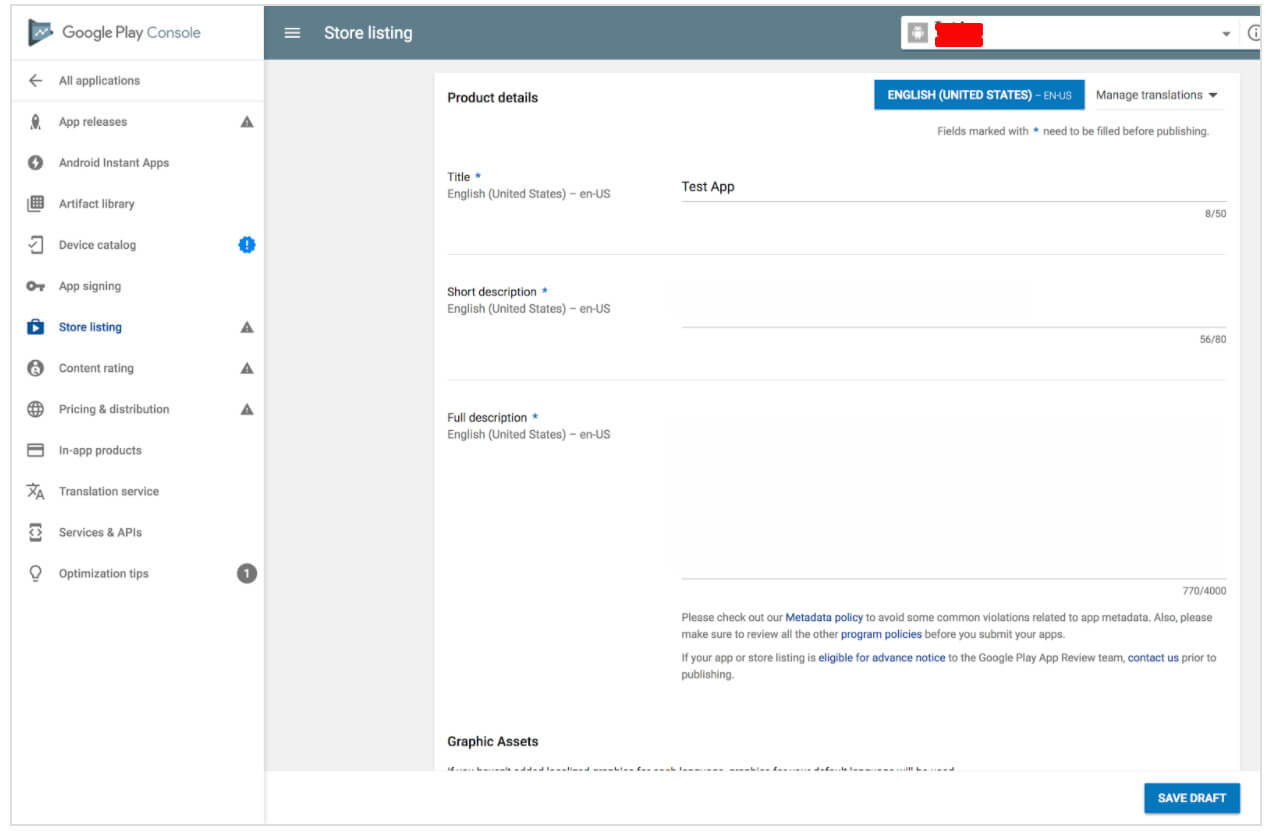
Screenshots
You can upload from 2 to 8 screenshots per device type. For apps, you must upload at least four screenshots with a minimum resolution of 1080px. These should be 16:9 for landscape (minimum 1920x1080px) screenshots and 9:16 for portrait screenshots (minimum 1080x1920px).
Make sure your screenshots reflect the actual in-app experience as well as showcase the core features and content.
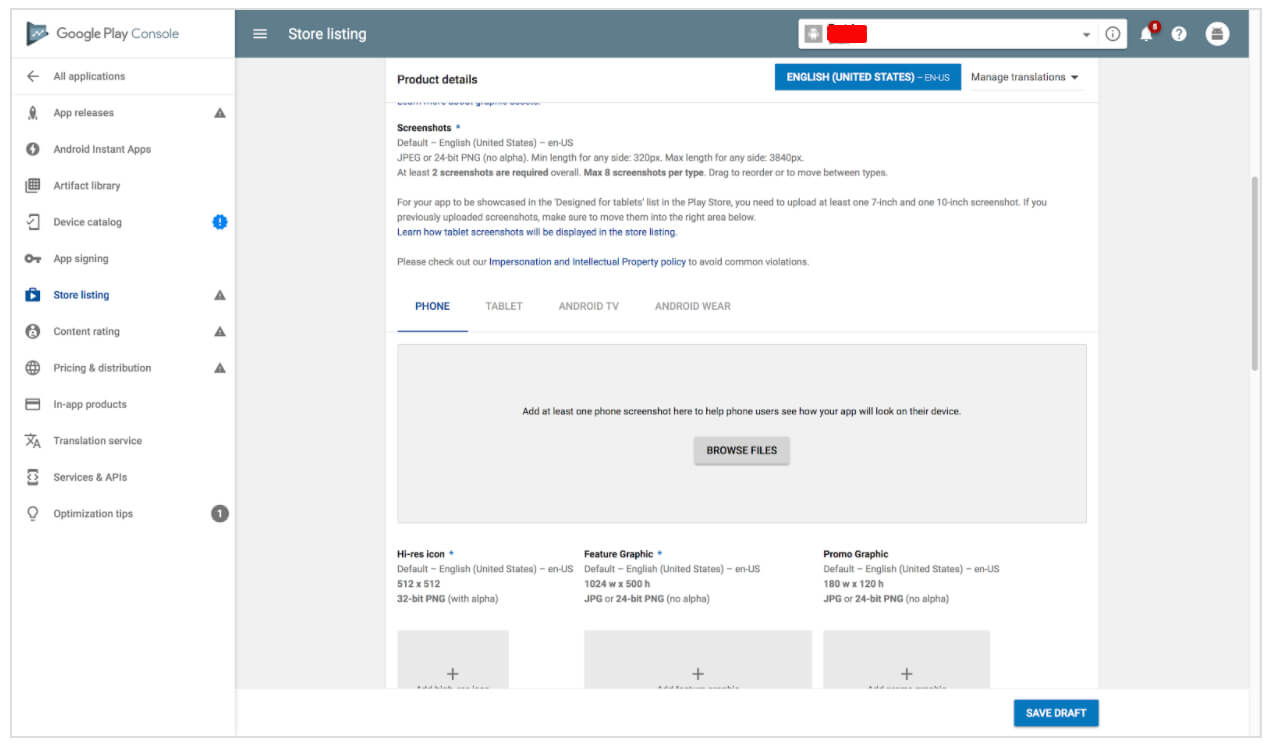
Icon
For an app icon, the requirements are the following:
- 512px by 512px — that's big enough to look sharp everywhere.
- 32-bit PNG (with alpha) — so it blends nicely with different backgrounds.
- Keep the icon under 1024KB for smooth uploads.
Feature graphic
The feature graphic is a promo image that appears in several places on Google Play, like curated collections or the top of your app’s listing. While optional, the feature graphic is highly recommended as it can significantly improve visibility and click-through rates.
The requirements for the feature graphic are the following:
- JPEG or 24-bit PNG (no alpha)
- 1024px x 500px
Promo video
If you have any promo videos, you may add a link to your YouTube channel directly in the app listing. This video will be displayed at the top of your app's page.
Tags
Unlike some app stores, Google Play doesn't allow custom keywords. When creating your app listing, you'll be able to choose from a predefined list of relevant keywords. Here's the trick: selecting the most accurate keywords will significantly boost your App Store Optimization (ASO) and help users discover your app.
Localization
If your app supports several languages, you can add translations for your app's Store Listing page, APK files, strings, or in-app products. It's highly recommended to include localized screenshots and images.
Application type and categorization
Through the drop-down menu, select whether your application is a game or a non-game app. Then pick the category that best fits your app's genre or purpose. You can also add a section to rate your content after uploading the APK to the Google Play Store.
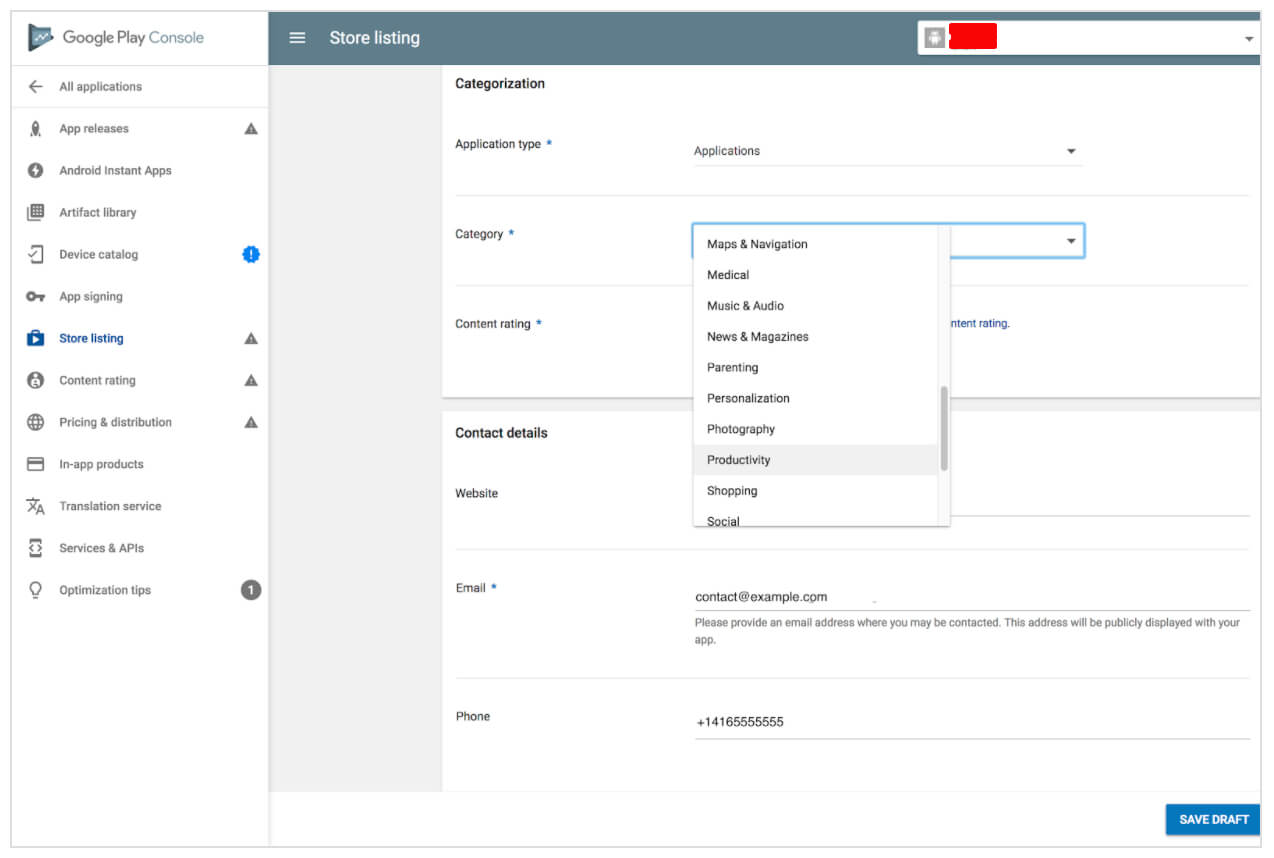
Contact details
Here, you should provide the support service contacts. By filling in the website URL, email address, and phone number, you make it easier for users to contact you if necessary.
Privacy Policy
Google requires you to add a link to the Privacy Policy that we mentioned above.
While editing the Store listing, you can take a break at any moment, click Save Draft, and complete this stage later.
Step 8: Content rating
To ensure your app is visible on Google Play and avoid potential removal, you'll need to complete a Content Rating questionnaire. You can easily find this section on the left-side menu.
You must provide accurate information for the questionnaire, as any misrepresentation of your app's content might lead to suspension or removal of the Google Play account.
- Click on Save Questionnaire once you complete the survey
- Click on Calculate Rating
- Сlick on Apply Rating to confirm the rating and move forward with the pricing & distribution plan
Step 9: Pricing and distribution
In the Pricing and distribution section, you need to fill in the following information:
- Whether your app is free or paid
- The countries where your app will be available
- Whether your app will be available only on specific devices
- Whether the app has sensitive content and is not suitable for children under the age of 13
- Whether your app contains ads
Remember that you can change your paid app to a free one later, but a free app cannot be changed to a paid one. If you decide later that you want to distribute the app for a fee, you'll need to create a new app with a different package name.
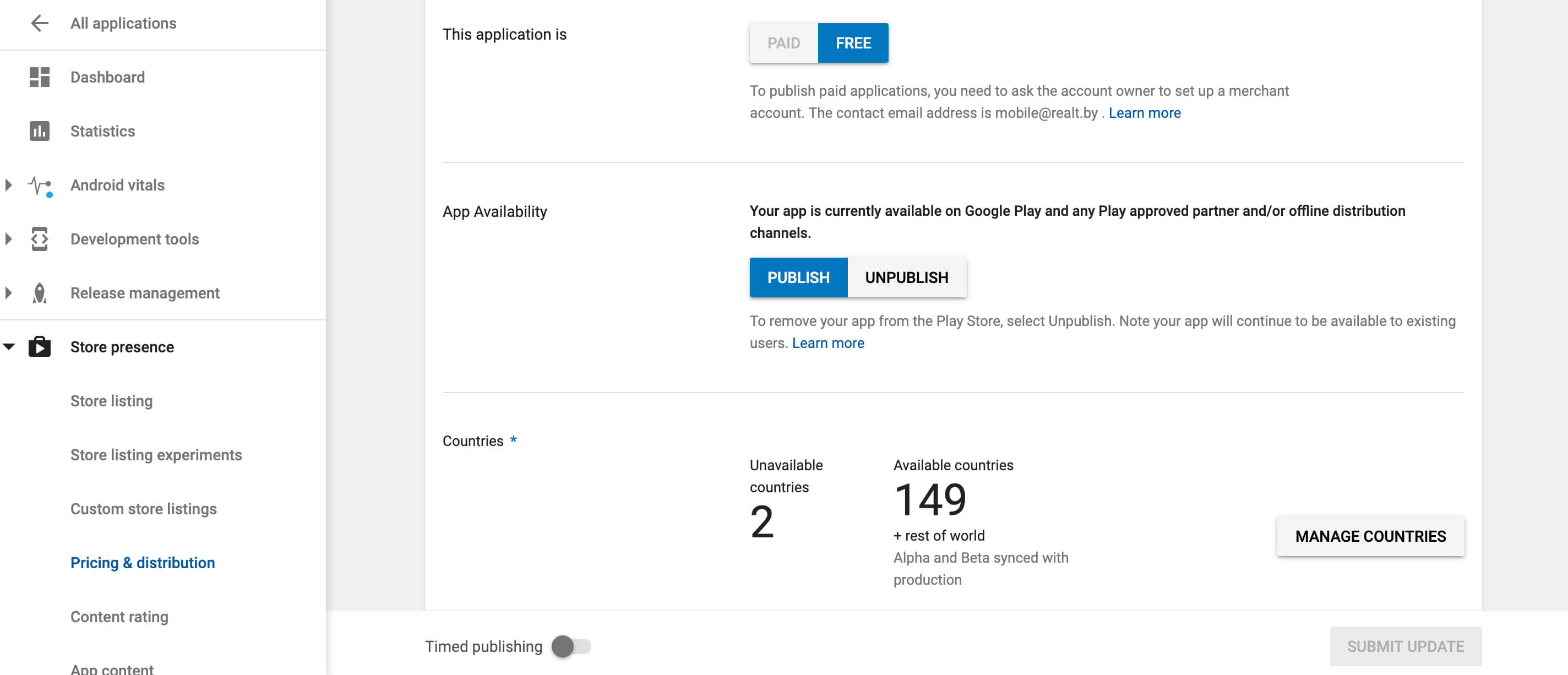
Step 10: Upload the APK and send it for review
Finally, you are ready to upload your Android app file. Head over to the App Releases section on the left panel. Here, you will find three options for publishing the app: Production, Beta, and Alpha tracks.
We highly recommend starting with the Alpha or Beta versions, because these allow you to test the app internally with a trusted group of testers. With Beta testing, anyone can sign up to be a tester and send feedback to you after giving your app a test drive. Pre-release testing allows you to gather feedback and fix issues before making the app public. Keep in mind that switching your app from Alpha or Beta to a Production release will trigger a new review process.
Once you choose the type of release, do the following:
- Choose Manage (Production/Beta/Alpha)
- Click on Edit Release
- Upload an APK or app bundle
The release name will be added automatically. For your first release, you can leave the What’s new in this release field blank or delete the placeholder text.
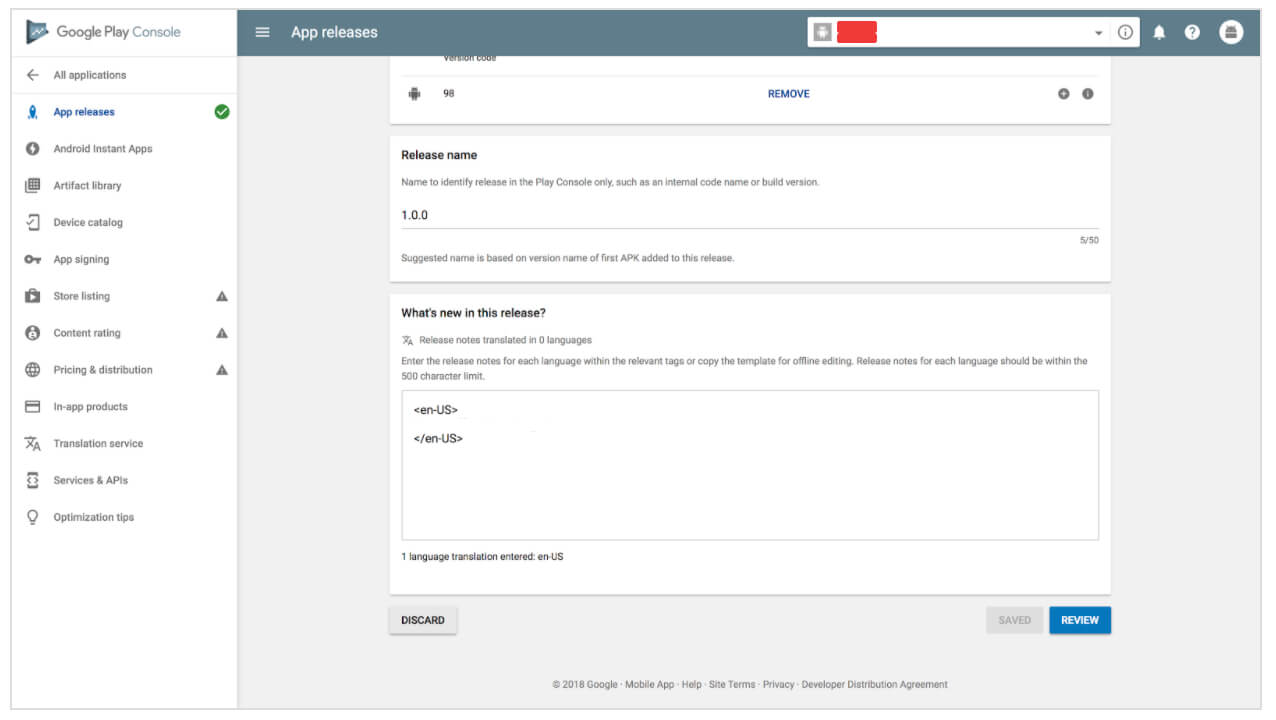
- Click on Review to confirm the changes and send your app for review by pressing Start rollout to production
Don’t worry about missing crucial details. Google Play offers helpful instructions and tips throughout the publishing process. Plus, the system won't let you submit your app for review if there are any critical missing pieces.
Remember that with the very first version, there is no opportunity to set manual publishing. Your app will be published immediately after it passes review. Usually, it takes up to 2 days. Google states that the review process may take up to 7 days or longer in exceptional cases.
Once the app is reviewed, you'll receive a notification on the Google Console Dashboard.
Wrapping up
We hope this guide will help you get the publishing process right and put your amazing mobile product in front of Google Play Store users. However, remember that the journey does not end with publication. Making your mobile application a long-term success requires an ongoing effort from your development team. Prompt troubleshooting, constant updates, and new releases will keep your app thriving in the long run.
Orangesoft's team can help you keep a watchful eye on your app's performance post-release and continuously refine it based on user feedback. Let’s work together to launch and grow your app successfully.
This article was originally published on GoodFirms
